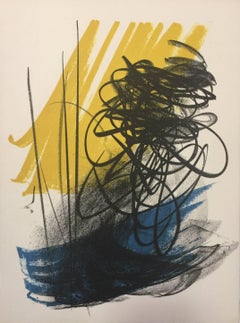Hans Hartung On Sale
Recent Sales
1970s Abstract Abstract Prints
Lithograph
1970s Abstract Abstract Prints
Lithograph
1970s Abstract Abstract Prints
Lithograph
1970s Abstract Abstract Prints
Lithograph
Hans Hartung for sale on 1stDibs
Hans Hartung is commonly presented as a standard-bearer for the École de Paris and the lyrical abstraction and is primarily considered as a post-war painter. Nevertheless, in the late 30s, this German-born artist had already participated in numerous exhibitions throughout Europe. His career began in 1922 at the age of just 18 years, when he didn’t even know the theories of Kandinsky but produced a series of abstract watercolors striking by their sheer expressiveness. This was the beginning of a career that lasted nearly 70 years and was punctuated by constant technical innovations. Paradoxical artist, Hartung was often at the opposite of the image the critics build of him, resulting in a distorted reception (Annie Claustres). Presented as a champion of gestural, lyrical and emotional painting, he remained passionate for mathematics, and his painting was apprehended through its rationality: from the 30s to the late 50s, he first produced small-sized works, spontaneously executed on paper; then he created the painting by laying down a grid and scaling up the small-size paper onto a canvas, referring point by point. The 60s also marked a turning point. Hartung stopped working by reproducing small formats but entered a patient search for technological innovation, including the production of multiple tools. In 1960, he won the grand prize for painting at the Venice Biennale, reaching the top of international recognition. Hartung never stopped creating, paintings with still more ardor until his last days in his property of Antibes that he had designed himself.
A Close Look at abstract Art
Beginning in the early 20th century, abstract art became a leading style of modernism. Rather than portray the world in a way that represented reality, as had been the dominating style of Western art in the previous centuries, abstract paintings, prints and sculptures are marked by a shift to geometric forms, gestural shapes and experimentation with color to express ideas, subject matter and scenes.
Although abstract art flourished in the early 1900s, propelled by movements like Fauvism and Cubism, it was rooted in the 19th century. In the 1840s, J.M.W. Turner emphasized light and motion for atmospheric paintings in which concrete details were blurred, and Paul Cézanne challenged traditional expectations of perspective in the 1890s.
Some of the earliest abstract artists — Wassily Kandinsky and Hilma af Klint — expanded on these breakthroughs while using vivid colors and forms to channel spiritual concepts. Painter Piet Mondrian, a Dutch pioneer of the art movement, explored geometric abstraction partly owing to his belief in Theosophy, which is grounded in a search for higher spiritual truths and embraces philosophers of the Renaissance period and medieval mystics. Black Square, a daringly simple 1913 work by Russian artist Kazimir Malevich, was a watershed statement on creating art that was free “from the dead weight of the real world,” as he later wrote.
Surrealism in the 1920s, led by artists such as Salvador Dalí, Meret Oppenheim and others, saw painters creating abstract pieces in order to connect to the subconscious. When Abstract Expressionism emerged in New York during the mid-20th century, it similarly centered on the process of creation, in which Helen Frankenthaler’s expressive “soak-stain” technique, Jackson Pollock’s drips of paint, and Mark Rothko’s planes of color were a radical new type of abstraction.
Conceptual art, Pop art, Hard-Edge painting and many other movements offered fresh approaches to abstraction that continued into the 21st century, with major contemporary artists now exploring it, including Anish Kapoor, Mark Bradford, El Anatsui and Julie Mehretu.
Find original abstract paintings, sculptures, prints and other art on 1stDibs.
Finding the Right abstract-prints-works-on-paper for You
Explore a vast range of abstract prints on 1stDibs to find a piece to enhance your existing collection or transform a space.
Unlike figurative paintings and other figurative art, which focuses on realism and representational perspectives, abstract art concentrates on visual interpretation. An artist may use a single color or simple geometric forms to create a world of depth. Printmaking has a rich history of abstraction. Through materials like stone, metal, wood and wax, an image can be transferred from one surface to another.
During the 19th century, iconic artists, including Edvard Munch, Paul Cézanne, Georgiana Houghton and others, began exploring works based on shapes and colors. This was a departure from the academic conventions of European painting and would influence the rise of 20th-century abstraction and its pioneers, like Pablo Picasso and Piet Mondrian.
Some leaders of European abstraction, including Franz Kline, were influenced by the gestural shapes of East Asian calligraphy. Calligraphy interprets poetry, songs, symbols or other means of storytelling into art, from works on paper in Japan to elements of Islamic architecture.
Bold, daring and expressive, abstract art is constantly evolving and dazzling viewers. And entire genres have blossomed from it, such as Color Field painting and Minimalism.
The collection of abstract art prints on 1stDibs includes etchings, lithographs, screen-prints and other works, and you can find prints by artists such as Joan Miró, Alexander Calder and more.

